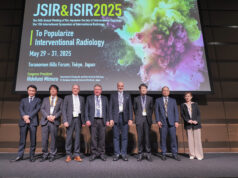
Over several decades, interventional radiology (IR) has scaled to significant heights, leading technological advancements and minimally-invasive techniques. As these milestones have been reached, however, historical pitfalls have deepened, prompting international discussion about the current structure of IR and the value of obtaining clinical specialty status. Building a figurative heatmap of IR’s progress to specialty today, Interventional News spoke to interventional radiologists around the globe to track the field’s burgeoning recognition, concurrent problems and future stability.
Introducing the ‘Applying for IR specialty status: lessons learned’ session at the Cardiovascular and Interventional Radiological Society of Europe (CIRSE) 2023 annual meeting (9–13 September, Copenhagen, Denmark), Michael Lee (Beaumont Hospital and Royal College of Surgeons in Ireland, Dublin, Ireland) asked: “What is wrong with IR?” Among his responses, Lee noted “there is little recognition, little visibility and most importantly, little credibility”. Speaking to Interventional News, Lee expanded on his statement, averring that visibility remains a “big issue”, rendering IR “completely invisible” to the health authorities who provide vital funding, as well as medical students in training who may elect to subscribe to IR.
“We are fishing in the wrong pond,” Lee averred, “[medical students] do not know what IR is. There is little mentorship or teaching—I am generalising, as there are excellent medical student educational programmes in certain large academic centres, but in the real world, outside of these large centres, medical students do not know who we are.” He described how, often, their “pond” is synonymous with trainees who enter diagnostic radiology but “not to do a hands-on specialty” like IR, they then must be “[convinced]” otherwise by interventional radiologists like Lee advocating for the specialty.
In New Zealand and Australia, the line between diagnostic and IR is equally blurred—Nick Brown (The Wesley Hospital, Auchenflower, New Zealand) explained that interventional radiologists are recognised as ‘special diagnostic radiologists’, which is the only specialty title available to fellows of the Royal Australian and New Zealand College of Radiologists (RANZCR). Brown is advocating for the creation of a ‘Specialist interventional radiologist’ title which would provide “an identity” to “elevate [IR] status and promote the high-value care that interventional radiologists provide to patients”.
To gain formal recognition for IR at his centre however, practice must be accompanied by an accredited training programme, said Brown. “Thus, RANZCR is working with the Society for Interventional Radiology in Australia and NZ (IRSA) and the Australian and New Zealand Society of Neuroradiology (ANZSNR) to develop, for the first time, two specialist training programmes in IR and interventional neuroradiology (INR).” Having an “identified pathway” to IR specialism Brown said, will “unlock the full clinical capacity of IR”, including the creation of clinical units and consulting rights, and could “attract appropriate funding and reimbursement for their departments and hospitals”, he stated.
Issues with ill-defined IR training pathways are also reported in the UK, as Raman Uberoi (The John Radcliffe Hospital, Oxford, UK)—recipient of the British Society of Interventional Radiology (BSIR) 2023 Gold Medal for his ‘outstanding contribution to the work of both the society and interventional radiology’—explained, outlining a culture of “jumping through hoops” to access IR in the UK. He noted how entrance to the field can be “vague”. Often trainees enter into radiology and learn about imaging for the first three years before having the option to broach IR, “and of course that [traces] many challenges,” Uberoi asserted. With distinct IR specialty status, he stated, trainees could bypass these challenges and “learn about imaging, but relevant to IR techniques and procedures, with a clearer distinction of what we are about and what we are going to do—it makes it much more attractive”.
Implementing a training curriculum that includes clinical practice and IR procedural skills “from day one” is crucial, agreed Lee: “That is why IR specialty status is so important. We must have a dedicated training pathway from the get-go to attract trainees interested in a ‘hands-on specialty’ like IR or the field will continue to be impoverished of trainees. In addition to trainee impoverishment, the other main limitation of current training programmes is the difficulty of producing IR specialists with the clinical expertise required to deliver the necessary patient care associated with current IR practice.”
In a co-authored article published in CardioVascular and Interventional Radiology (CVIR) earlier this year, Lee and Uberoi collectively discuss the third and latest edition of the CIRSE European Board of Interventional Radiology (EBIR) curriculum, which forms a distinct syllabus and examination of IR competence throughout Europe. The latest iteration places focus on “greater clinical responsibility for patients”, defining “core competencies [..] to improve the future training and quality of interventional radiologists worldwide, improving patient outcomes and care”.
Parag Patel (Medical College of Wisconsin, Milwaukee, USA) who also presented at CIRSE, spoke to Interventional News to provide insight on behalf of IR in the USA, which gained primary specialty status in 2012. Patel explained that recognition for IR in the USA enabled the specialty to “not just highly encourage or strongly suggest, but require, base-line competencies in training for interventional radiologists.
“Primary specialty recognition allowed us to fundamentally change those requirements, expanded the training to two full years of IR training, not just procedural but clinical intensive care unit management admission discharge,” Patel highlighted.
Certification of this programme by the Accreditation Council for Graduate Medical Education (ACGME) and IR specialty recognition from the American Board of Medical Specialties (ABS) has also improved recruitment, with Patel noting an uptick in senior medical students applying to join the clinical specialty. “These are future leaders—these are bright, young individuals who would have been leaders in vascular surgery, cardiology, oncology, and are now going to be leaders in IR,” he said, emphasising their “elevated workforce of talent”.
Yet, Patel remarked, “there are always growing pains”, explaining how IR is still “[appropriately]” housed within the department of radiology. Although their chairman, who oversees their division, understands imaging, they “do not always understand how to support [IR] clinical practice” he stated.
For Lee, clinical practice and longitudinal care represents a clear distinction that can be made between the needs of IR and diagnostic radiology, but without primary specialty or a chairman who is an interventional radiologist, asking for dedicated time for clinical practice “is met with friction and confrontation” he said. Uberoi added that longitudinal care is a “critical” feature of IR, and for patients, knowing that the doctor who initially assesses you will be the one to treat you and to whom questions can be directed is essential. Without the “trust and communication” that is built through regular touchpoints with a dedicated specialist who takes “ownership” of their patients, interventional radiologists are left with “unrealistic” and ineffectual practices today, said Lee.
Equally, this remains an issue in the USA, Patel conveying that “if IR is not given the same [recognition] in its ability to see patients and manage them in a multidisciplinary format, then we are not supported and frankly our treatments will not be advocated for”. He explained it is a “rare instance” that a specialty will advocate for another’s procedures, and that only your own specialty will be willing to do so, proving that ultimately “if you are not at the table, you are on the menu, as they say”, Patel punctuated.
As the frequency of these conversations increase, the “deficiencies” in IR are thrown into light, Lee conveyed, but the “chance to talk to the right people about what IR is all about and its problems” has been instrumental in sparking progress. “We now have a national programme for IR in Ireland to look at the current situation. Over the next 10–15 years, IR should be a robust part of Irish healthcare and hopefully a primary specialty. This may have never happened if we had not embarked on this—I always remember that song and Mick Jagger singing: You can’t always get what you want, but you may get what you need.”
Despite positive conversations, the speakers concurred that unanimous action to strengthen the field of IR “not because you feel it is better, but based on what is best for patients” as Patel stated, is still crucial. For Brown, a strategy of “good planning and perseverance” has promised a formal training programme by 2026, with specialty status to shortly follow, which he believes will be the “single greatest boost to IR practice in recent times”.
Finally, the speakers agree that these changes must happen to secure IR practice for the future, in Lee’s words: “If we do not take control and if we do not take charge of our own destiny, we will be jeopardising the future sustainability of IR. Maybe I am being a little nihilistic, but I believe that we must start changing things and it needs to happen sooner rather than later.”










